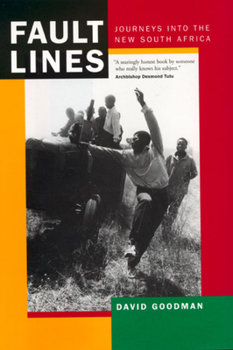Fault Lines: Journeys Into the New South Africa Volume 56
(Part of the Perspectives on Southern Africa Series)
Select Format
Select Condition 
Book Overview
South Africa has experienced one of the world's most dramatic political transformations. David Goodman, a journalist and activist who has witnessed South Africa's struggles since the darkest days of apartheid, chronicles the historic transition from apartheid to democracy. This compelling story is told through the lives of four pairs of South Africans who have experienced apartheid from opposite sides of the racial and political divide. Taken together, these profiles provide the first in-depth look at the social dynamics of post-apartheid South Africa.
Part social history and part personal drama, Fault Lines is an account of what happens to real people when their country is reinvented around them. The struggle to reconcile past evils is captured in the stories of a former police assassin and his intended victim. The rise and fall of South African racism is portrayed through the lives of the late Prime Minister H.F. Verwoerd-the notorious "architect of apartheid"-and his grandson, now a member of the ruling African National Congress. The battle to break out of poverty is detailed in the story of two black women: one an impoverished domestic worker and new city councilor, the other a Mercedes-driving member of South Africa's new black elite. The struggle for the land is told through the eyes of two neighbors: a black farmer who was evicted from his lands in the 1980s and has returned to start over, and a conservative white farmer who participated in the eviction and now does business with the man whose life he nearly destroyed. These powerful stories are accompanied by the photography of award-winning South African documentary photographer Paul Weinberg.
Part social history and part personal drama, Fault Lines is an account of what happens to real people when their country is reinvented around them. The struggle to reconcile past evils is captured in the stories of a former police assassin and his intended victim. The rise and fall of South African racism is portrayed through the lives of the late Prime Minister H.F. Verwoerd-the notorious "architect of apartheid"-and his grandson, now a member of the ruling African National Congress. The battle to break out of poverty is detailed in the story of two black women: one an impoverished domestic worker and new city councilor, the other a Mercedes-driving member of South Africa's new black elite. The struggle for the land is told through the eyes of two neighbors: a black farmer who was evicted from his lands in the 1980s and has returned to start over, and a conservative white farmer who participated in the eviction and now does business with the man whose life he nearly destroyed. These powerful stories are accompanied by the photography of award-winning South African documentary photographer Paul Weinberg.
Format:Paperback
Language:English
ISBN:0520232038
ISBN13:9780520232037
Release Date:March 2002
Publisher:University of California Press
Length:428 Pages
Weight:0.57 lbs.
Dimensions:1.0" x 6.0" x 9.0"
Customer Reviews
2 ratings
Views from both sides
Published by Thriftbooks.com User , 21 years ago
Goodman has compiled a great book here with views on important events in South African history. These events are examined with narratives from both sides, white and black. The aftermath of each event is traced as well.
Expands on what I saw in South Africa, October, 1998
Published by Thriftbooks.com User , 25 years ago
Having visited South Africa in October, 1998, and seen the extensive squatters areas described by the author, I do not believe that readers of his book can adequately understand the extreme poverty he describes. It has to be seen and experienced to be appreciated. Mr. Goodman's portraits of the eight people in his book gives flesh and humanity to the otherwise dehumanizing nature of apartheid. I think his work is best appreciated if you have seen South Africa for yourself. For your readers who have not been to South Africa, they owe it to themselves to see it. I believe you can not remain unmoved by what you see and one must come away from that experience a better person.






